by Preeti Madhusudhan
The December romance that Tamil Nadu exudes is brilliantly captured in the 3000-year-old poems of the warrior-poet Thirumangayazhwar. So elegant are his choice of words, such skill in their usage, that his poems are a beacon light to the cult of abject love and surrender that such a love commands. It is with fervor similar to a fashion aficionado’s who flocks the Paris fashion week, that we set out in his path. With a base camp at Kumbakonam, we have already visited the famed Tiruvelliyangudi, Pullamboothangudi and Aarvamudhan temples.
The region around Tiruvali a small town 60 kms from Kumbakonam, a southern city of phenomenal cultural importance, is Kaliyan’s homestead. The sweeping spread of emerald green fields pregnant with the latest harvest, the innumerable water bodies that encapsulate the ancient temples, all find a poetic mention in Kaliyan’s verses. Though he composed verses on 88 of the famed 108 Vaishnavite sites, including songs on the distant Saligram (in Nepal) and Badrinath, his songs about temples around his home in Tiruvali, are especially close to our hearts, as the scenery and the very air reflect the fertile imagination of this superior poet. These sites and this landscape molded a warrior and a highway robber into an Azhwar.
In the second decade of his epic Tirumozhi, a composition of 1084 hymns, he sings placing himself in the role of the heroine’s mother, of the plight of her love-struck daughter
Scented unguents and sandal paste
These though she applies on her bosom
That the gentle moon rays burn
The rumbling ocean torments, she laments
Her tender body glows golden with pangs of separation
Her bangles slip from her frail hands
What do you intend to do of this girl
O lord of Tiruvidandai
The songs of this decade dedicated to the reclined Lord Vishnu at Tiruvidandai are perhaps one of the most romantic of the poet’s composition .Yet it 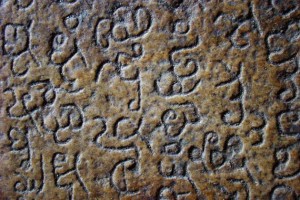 is the Lord of Tirunaraiyur who got the madal from the poet. A madal is a set of verses that proclaim a man’s love for his nonchalant lover. It is said that Lord Ranganatha asked Tirumangaiazhwar to compose a madal on him for which he received a delightfully cheeky reply. “Madil inge, madal ange”, “compound wall (Madil, the wall that surrounds a temple) here, verses there (referring to Tirunarayur)”. The Srirangam temple owes its enclosing walls to a large extent to Azhwar. Azhvar collected ( resorting to scheming, conniving and thieving when straightforward collection didn’t produce results) funds and oversaw the construction of the great compound wall of the Srirangam temple-city complex.
is the Lord of Tirunaraiyur who got the madal from the poet. A madal is a set of verses that proclaim a man’s love for his nonchalant lover. It is said that Lord Ranganatha asked Tirumangaiazhwar to compose a madal on him for which he received a delightfully cheeky reply. “Madil inge, madal ange”, “compound wall (Madil, the wall that surrounds a temple) here, verses there (referring to Tirunarayur)”. The Srirangam temple owes its enclosing walls to a large extent to Azhwar. Azhvar collected ( resorting to scheming, conniving and thieving when straightforward collection didn’t produce results) funds and oversaw the construction of the great compound wall of the Srirangam temple-city complex.
To this Tirunarayur thence we proceed early next morning.
There is a rush to alight from the car, as we reach Nachiyar koil, as Tirunarayur is known in the non-Vaishnavite parlance. One sight of the granite-pillared front Mantap of the temple was enough to cool our heels. Contrary to the design of the typical elaborately sculpted Dravidian pillars, the pillars here sport a contemporary stark, chicness. Black, massive and cylindrical, this colonnade serves the probable notion of the builder to subjugate, inspire awe and instill the sense of minuteness. Conversely, they also assure the devotee as he walks in looking up at the capitals of successive pillars, of the eternal security and refuge he obtains at the feet of the Lord. Seated atop progressively steep sets of granite stairs, are the majestic Lord Srinivasa and His consort. Unusually seated in a separate sanctum at right angles to the Lord, is the stone Garuda atop whom the processional image of the Lord is carried out during the temple festivals.
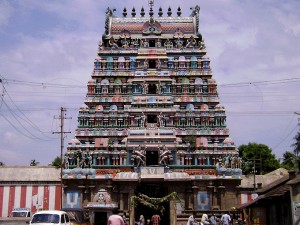 This is the Lord who initiated Azhvar into the lofty lineage of Vaishnavite saints. The mortal love that Kaliyan had for lady Kumudavalli blossomed into a love for the Almighty and it was here that it received official sanction and acknowledgement. And Kaliyan expresses his gratitude in 100 hymns of the Tirumozhi and both the short and long Madals.
This is the Lord who initiated Azhvar into the lofty lineage of Vaishnavite saints. The mortal love that Kaliyan had for lady Kumudavalli blossomed into a love for the Almighty and it was here that it received official sanction and acknowledgement. And Kaliyan expresses his gratitude in 100 hymns of the Tirumozhi and both the short and long Madals.
At this juncture we should pause to admire the poetic prowess of Tirumangaiazhvar. Adept at all four styles of Tamizh poetry, covering spontaneity, poetry with a specific structure, pleasantness and prowess, Tirumangaiazhvar was called “Naarkavipulavar” – poet of four styles. Kaliyan’s works help deconstruct and delineate Nammazhvar’s works, just as the Upanishads do to the vedas. Mastery over the Tamizh language yielded a confidence to the titillating words of Kaliyan, so much so that he was gifted a spear by Tirugnyanasambandar, a contemporary Nayanmar, when he extemporaneously produced a hymn on Lord Thaadaalan at Chidambaram acceding to the request of the Nayanmarr.
A way with words, the noble bearing of a fierce warrior, delightful mischief and an unrelenting steadfastness in love; one can’t help but envy lady Kumudavalli.
About 40kms from Tirunarayur is Tirukannapuram, one of the most significant Vaishnavite shrines, having pocketed a 100 verses from Kaliyan. It is believed by staunch Srivaishnavites that the Lord at the lofty zone of eternal peace denies liberation to the souls at his gates, if they haven’t had a darshan of Him at Tirukannapuram.
Poets take anything as their muse. Flowers, trees, the moon, even an ancient Grecian Urn. To our poet who melts at the sight of a bee drinking honey, the flow of his beloved Ponni, what would the result be if the subject of his ruminations is the divine lover, Krishna?
He who is the music, the musicality, as sweet as milk
Is the cream of milk, is omnipotent, being
the space, He who is an effulgent flame
Is the sacrificial fire, is the light of the lamp
The soil, the mountain, the water
The night sky, the moon, the knowledge
Of learned men, to my eyes contentment
I saw at Tirukannapuram
And then the perspective of Azhvar changes from being that of a humble devotee marveling at the immensity of the Lord, to that of a concerned mother querulous about the plight of her daughter (also Azhvar) lost in her love for the lord of Tirukannapuram.
From a moon-drenched courtyard, this girl gazed out
Behold Kannapuram she pointed
Bolstered by her lover’s emissary, lost has she
All modesty; under the auspices of the One of Naraiyur.
Adjoined by an immense tank, the temple stands proud and alone but for a few houses by its side. The lord stands tall at about eight feet, surrounded by his retinue. Every temple here has a legend, invariably that of a divine vision granted to a Maharishi, a Tapasvi, and or to pardon someone’s sin. These blessed souls too are represented tall and handsome, in postures of supplication and eternal bliss. So there He is, with an entourage; quite the celebrity with his regal countenance. One can almost hear the clicks of multiple flashlights. There is something else intangible yet distinctly perceptible here. Call it the imagination of a pre-conditioned mind or sheer infectious romanticism, but the Lord here is discernibly ancient, and looks nothing like idols seen anywhere else. And when one peers in the semi-darkness the bare outline of a smile emerges on His delicate lips. That smile is the full-moon that suddenly bursts out from under dense clouds. It brings to mind the words of another poet from a distant land, Christopher Marlowe: “The face that launched a thousand ships”
Yes, definitely the face that can launch the words from a thousand poets.
Our senses satiated, we take leave of the Lord Neelamegam of Tirukannapuram. There is an air of triumph in the car. The quiet roads make way for the bustle of a busy city, Nagapattinam. The paddy fields are gone, and so too is the sun. Dusk brings to mind Somerset Maugham’s observation on the tropics, that dusk seems too come all of a sudden. How true. In seconds, the vivid orange horizon is pitch-black. We arrive at Nagapattinam temple.
Such is the divine countenance of Lord Soundarajan of the Nagapattinam temple, that Azhvar calls him “Naagayazhagiyaar- the beauty of Naagai”. He 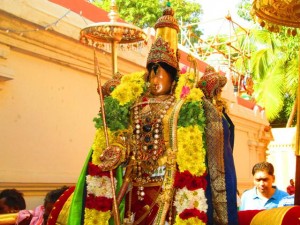 sang 10 songs on the lord here, all ending with the words “Achovoruvarazhagiyava,” referring to His handsome countenance. The Tamizh word “acho” stands for exclamation, awe, helplessness and admiration. Azhvar has used the word to simultaneously mean all of these emotions in his 10 songs and in true Kaliyan style, abject love! The erudite, expressive poet is at the end of his tethers here. How does one describe what he sees at this temple?
sang 10 songs on the lord here, all ending with the words “Achovoruvarazhagiyava,” referring to His handsome countenance. The Tamizh word “acho” stands for exclamation, awe, helplessness and admiration. Azhvar has used the word to simultaneously mean all of these emotions in his 10 songs and in true Kaliyan style, abject love! The erudite, expressive poet is at the end of his tethers here. How does one describe what he sees at this temple?
Grown tall as clouds, grazed by the moon is
Maliruncholai, whose Lord came and
positioned himself in my heart and eyes
Or is it the master of Neermalai, am unable to say;
Grown tall as clouds is a golden mountain
Come see Him, the dark cloud atop that
He came riding a handsome bird
Oh! (Acho!)The beauty of the Supreme
And the priest here sings all the ten verses pausing to elaborate the meaning prescribed by our preceptors. His golden voice rings majestic, ricocheting off the walls of the sanctum, the rising and falling intonations plays with the sentiments of the devotees. The beginning of every verse brings new joy, and we marvel at the language, the poet and the subject, the Lord. But every finial “Acho, Such beauty” sees the satiation of this joy resulting in priceless expressions. The men both young and old have dour faces, veins taut, eyes threatening to release the floods of rapture. The women are near hysteria, they have the most beatific smiles drenched by the monsoon of their joy, their saree pallus soaking wet. I looked at my son ready with a look of remonstrance lest he is tickled and laughs. But no, he is too bewildered, entranced by the priest’s singing.
As we will see in the concluding part, with deeds bordering on communal chauvinism, Azhvar is still quoted in modern-day Buddhist texts, as the man who was instrumental in the downfall of that religion in these parts. On the final day that winds up this surreal journey, we travel to his birthplace, the hamlet, Tiruvali where he wed his lady-love received enlightenment. We wait, with bated breath, to finally have a glimpse of the Azhvar himself in all his regal glory.
Read the first part here.
Preeti Madhusudhan is a freelance architect/ interior designer living in Sydney with her husband and eight-year-old son. She is passionate about books and is an ardent admirer of P.G.Wodehouse. She inherited her love for books and storytelling from her father, a Tamil writer. Preeti is trying to publish her maiden novella in English.

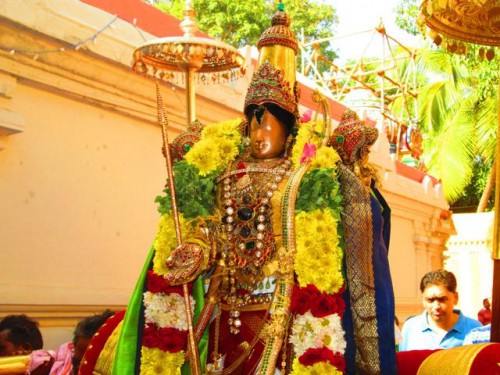




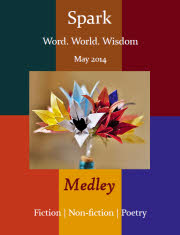
Fantastic !! Awesome !!!
Double Delight. Awesome. Anuradha Soundararajan, anu.sounder@yahoo.com
Fantastic !! Awesome !!!
WOW !!
Double WOW!!!